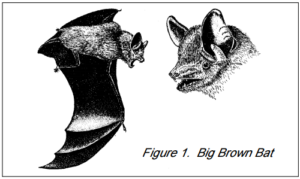 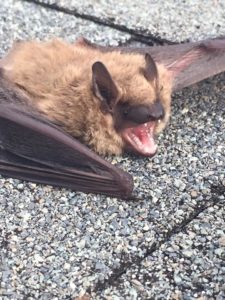 |
|
Big brown bat |
Bats are among Indiana’s most interesting and unique mammals and probably one of the most misunderstood. There are many myths concerning bats that cause some people to unnecessarily fear these mammals. Bats are, for the most part, harmless. They rarely, if ever attack people or “get tangled in your hair.” In fact, most bats in the U.S. are biologically useful mammals. They feed primarily upon insects, many of which are pests to agriculture. However, bats can be pests if they take up residence within buildings. There are good reasons for not tolerating their presence. The scratching and squeaking noises they create are annoying. Their droppings and urine not only stain walls and ceilings, but also cause objectionable, persistent odors that may attract insects and other bat colonies, even after the original colony is eliminated. Long-term accumulation of these droppings in attic spaces has been associated with the respiratory disease Histoplasmosis. This disease is caused by a fungal spore called Histoplasma capsulatum. Bat and/or bird droppings that have decomposed from 2-5 years or longer provide an ideal habitat for spore growth and reproduction. And finally, there is a slight chance of someone contacting a rabid bat, although the great majority of house-infesting bats in Indiana are NOT rabid.
Identification
Bats belong to the order of mammals called the Chiroptera, which means “winged hand.” Because they possess wings, bats are the only mammals capable of true flight. Although they have functional eyes, they rely on their “radar system” to navigate their swift and unerring flights through dense tree growth and other obstructions.
There are 12 resident species of bats in Indiana. Most roost in caves, hollow trees and other natural shelters. A few species, however, commonly roost and breed within occupied buildings during the warm-weather months. The two species most frequently encountered by homeowners are the big brown bat (Eptesicus fuscus) and the little brown myotis bat (Myotis spp.).
The big brown bat is relatively large, measuring about 4 inches in length and having a wing span of 12-14 inches, but weighs only 1/2 ounce. The body and wings are usually dark brown; the ears are blackish. The little brown bat is about 3 inches long, chocolate brown and weighs 1/4 ounce. Although these two species vary in size, they are easily confused and usually only an expert can tell them apart. Brown bats live an average of 4-10 years.
Biology and Behavior
|
Adult weight:
|
Big brown (1/2 ounce), Little brown (1/4 ounce).
|
|
Total length:
|
Big brown (4 inches), Little brown (3 inches). |
|
Color:
|
Dark brown. |
|
Gestation:
|
Big brown: 60 days, Little brown: 50-60 days. |
|
Litter size:
|
Big brown: 2, Little brown: 1.
|
|
Life span:
|
4-10 years.
|
During the first warm days of spring, the brown bats leave their overwintering sites and enter structures. The majority of these bats are females preparing to give birth. These groups are called nursery or maternity colonies. The number of individuals in a colony may range from a few to several hundred. Generally, if the colony contains more than 200, it is likely they are little brown bats.
The babies are born during June and July. The big brown bat female produces two young, while the little brown bat female produces only one. Juvenile bats are breast-fed until they are mature enough to fly and obtain their own food (from 3 to 7 weeks). Bats usually remain in their roosts all summer.
During September and October, males increase in numbers at the roost and mating occurs (the sperm is “stored” by the female during the winter, and fertilization occurs in the spring when she departs from hibernation). As temperatures begin to drop in mid-October, the bats leave their summer roosts and travel to their overwintering quarters.
Hibernation sites vary among different colonies of bats. Little brown bats hibernate as colonies, selecting caves instead of buildings to pass the winter. Big brown bats on the other hand, disperse and hibernate individually or in small groups utilizing various sites including hollow trees, rock crevices, drainage pipes, and caves. Usually, they do not hibernate as colonies within buildings. But it is common for small numbers of bats (typically 1-4) to hibernate in homes and other buildings if the attic or walls provide a suitable environment for surviving the winter. These bats sometimes become active during either unseasonably cold or warm days of the winter, causing concern among homeowners that a colony of bats might be inhabiting the home all year long. But the same bats which overwinter in one structure may use a completely different building for their summer roost. In cases of winter sightings, the attic should be inspected for structural deficiencies, and all openings should be sealed as described under bat proofing.
Roosting Behavior
While all types of buildings are susceptible to bat infestation, certain factors seem to make some structures especially inviting as “maternity roosts.” For example, bats usually select buildings located near water (streams, lakes, ponds, etc.) and food (i.e., where insects are found in adequate numbers). Also, there is some support for the notion that bats are attracted to buildings by odors from previous infestations, coupled with high roost temperatures which are conducive for rearing young. And, of course, the structure must be accessible (i.e., the bats must be able to get in and out). Actual roost sites within a building are either (1) in concealed areas like roof and ceiling voids, brick voids, etc. or (2) in exposed areas such as ceiling joists and roof rafters (Figure 2).
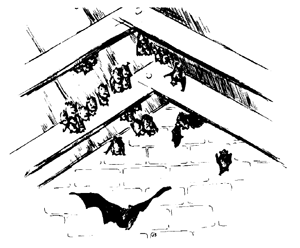 |
|
Fig. 2. Among the roosting sites of bats within buildings are dark, draft-free, upper exposed areas like roof rafters or ceiling fans. |
During the day, bats remain in a restful or semi-restful state. They emerge from the structure beginning at dusk. Most of the bats will be out of the roost within 60 minutes from the first bat’s exit. Then they fly to feeding and watering areas, which often will be a field and/or stream near the roost structure. By dawn, the bats are back in the roost.
Inspecting for Bats
There is no need to panic if a bat is seen flying around inside the home. It may mean nothing more than a bat flew in through an open window or chimney. However, it’s presence could signify that a colony is living in the attic. Bat colonies within homes and buildings may range between a dozen to several hundred bats.
To determine if a colony exists, a simple outdoor inspection of the home’s roof area should be conducted at dusk, when house-infesting bats emerge for feeding. This inspection should reveal the exit and entry points of the bats or structural deficiencies of the building and size of the infesting colony. It is important to remember that if bats are present, they will emerge each evening, except in cases of inclement weather.
To make the inspection, situate two people at opposite corners of the structure so that each can view two roof areas at the same time (if a building has several wings, more than two people may be needed). Begin the inspection approximately 1/2 hour before dusk and continue for about an hour after the first bat emerges.
Common exit points include attic vents, rooflines (e.g., between the roof sheathing and the fascia boards), and any openings resulting from building deterioration (Figure 3). Openings of only 3/8 inch are sufficient for bat entry. In some cases, such as barns, exit and entry points may be the actual doorways. Exit/entry locations can also be determined by preemergence noise, droppings below the exit points, odor, or smudge marks in the areas of entry.
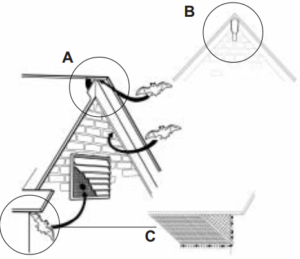 |
|
Fig. 3. A) Bats only need an opening of 3/8 inch to invade a space; B) Cloth funnel exit; C) Plastic netting exclusion. |
An inspection inside the home, particularly in attic areas may also reveal evidence of bat activity. You may see the bats themselves hanging from rafters in dark, secluded spots in the attic, you may find the remains of a dead bat, or you may find accumulations of bat droppings on the floor. Old, dried bat droppings sometimes have a “coffee grounds” appearance. To minimize any risk of exposure to Histoplasma, precautions should be taken to safely clean up and remove those droppings if significant accumulations of old bat droppings are found. Lightly mist the droppings with water in order to avoid stirring up dust. Scoop up the droppings and put them in plastic bags. If desired, cleaned surfaces may be sprayed with a 2% bleach/water sanitizing solution or a hospital quality fungicide. At minimum, a respirator and disposable gloves should be worn during any droppings clean up.
Controlling a Nusiance Bat Colony
Exclusion
Making a structure “bat proof” is the best long-term, cost-effective, and biologically acceptable way to control bats. Remember, the objective in controlling bats is to rid a building of the colony permanently. Exclusion is the only method that can guarantee this goal.
The best time of the year to bat-proof a building is either in late fall after the bats depart for hibernation, or in late winter/early spring before the bats arrive. If, for some reason, it can only be done during the summer, the preferred time is mid-August or later and in the following manner:
- seal all but one or two of the principal openings, and wait 3-4 days for the bats to adjust to using the remaining openings;
- install a one-way exit so that the bats can leave but not re-enter the building (one-way exits can be made by using a mesh screen funnel over the exit hole, installing a “bat checkvalve”, or by securely attaching the end of an old pant leg around the remaining exit holes, thereby forming a chute for the bats to crawl out through (Fig. 3B)); and then
- permanently seal those openings after there is no longer any evidence of bat activity.
External exclusion programs should never be attempted mid-May through mid-August (nursery phase), because the young will be trapped within the structure and die, creating odor problems. Preventing bats from entering occupied rooms is usually a primary concern for those people experiencing a bat infestation. During this nursery phase, exclusion programs can be focused on the interior areas of the building using the same exterior guidelines listed below.
All openings 3/8 inch and larger must be sealed (Fig. 3A). For permanent sealing, use materials such as 1/4- inch hardware cloth, sheet metal, plywood, mortar, or aluminum flashing. For temporary exclusion, rags, steel wool, weather stripping, or foam sealants can be used.
In some cases, such as very large, older buildings, excluding the bats will require a substantial amount of time to repair all the holes the bats are using to gain entry. There are, however, various products that provide practical, economical, permanent exclusion even for buildings like barns.
One product is a plastic bird netting (Fig. 3C). Although developed primarily to protect high-value agricultural crops from birds, it is also used to exclude birds from structures and can be used in bat control. The netting is very light, supple, yet relatively tough and resilient; it is easy to work with and relatively inexpensive. Depending on the situation, it can be draped over entire roof areas, or cut and applied as needed to cover only certain sections.
It may be practical in some situations to net the susceptible parts of a building during April and May (when the bats begin arriving). The net then can be removed and stored until the following spring. Information concerning manufacturers of plastic netting for bat control can be obtained by contacting the USDA APHIS Wildlife Services Program located at Purdue.
Various caulks or foam sealants can be used to seal cracks and crevices in walls.
Bat Repellents
If, for some reason, bat proofing is not possible or bats need to be forced out of a building before an exclusion program is begun, repelling methods can be attempted. In most cases, they are not very successful.
Sudbury’s Bat Repellent and Dr. T’s Bat Scat are currently the only chemical bat repellents registered in Indiana that can be used in structures. In most cases, chemical repellents are not very effective. When sprinkled in areas where only a couple of bats are roosting in small confined air spaces, such as tight attic spaces, double walls, between roof and attic ceilings or other boxed-in areas, it may encourage the bats to leave the building. Keep in mind that the repelling effect is only temporary, and treatments must be repeated every few weeks. Moreover, the bats may simply move to another part of the building where there is no repellent odor. Also, repellents should not be used if humans are exposed to constant inhalation of the odors. Some individuals are sensitive to these products and, thus, should avoid contact with the material.
Fiberglass Insulation. Some bats may roost temporarily during the night in open structures or on outside areas of homes, such as garages, carports, patios, behind shutters and building overhangs. Bats sometimes can be discouraged from using these areas by tacking coarse fiberglass batting to the specific areas where they hang.
Bright Lights. In cases of small attic areas, bright lights may repel bats. Attics can be illuminated using four or more 150-watt bulbs; direct the lights at the entry points. These lights should be turned on after the bats have left for their evening feeding. Thus, they will have to return into the bright light, something they will be adverse to doing. Although illumination has been successful in a few cases, it is not very practical for most situations, such as bat infestations in larger buildings. Bats have sometimes been observed feeding on the insects attracted by outside lights.
Drafts and Air Conditioning. Drafts of cool air within roosts will sometimes repel bats from a structure. Thus, carefully directed breezes produced by electric fans may prove successful.
Air conditioners installed in bat roosts and turned on during April and May discourage bats from roosting since they prefer high temperatures for rearing young. This approach might be worth a try where exclusion cannot be achieved.
Ultrasonic Noise. Despite some claims, none of the ultrasonic sound devices have been found effective for repelling bats from buildings.
Poisoning
People occasionally inquire among pest control professionals as to whether or not the nuisance bat colony can be “exterminated” by applying some kind of poisonous material. This is not an acceptable control alternative because there are no poisons that can be legally used for bat control. Besides, poisoning bats might only worsen the situation. The bats may die in an inaccessible area within a building, thereby creating an odor problem. Also, bats affected by the poison could disperse over an entire community before dying. This may increase the chance of contact with a child, dog, cat, etc., thereby increasing the potential for a “rabies scare” and/or a possible rabies exposure.
Bat Houses
Recently, bat houses have become commercially available. Most of these houses are designed to be attached to trees or the sides of buildings. But the factors involved in bats selecting their roosts are relatively complex. Location, temperature, humidity, orientation of the house, roost height, and other biological factors determine whether or not bats will utilize a particular area or structure. Although there have been a few cases of success, research thus far has shown that most of the commercially available “homeowner style” bat houses are not very effective in attracting bats.
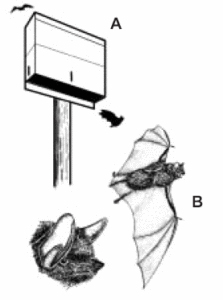 |
|
Fig. 4. A) Bat house; B) Little Brown Myotis |
Nevertheless, bat houses are fun to try, provide a great educational vehicle to teach young people about bats, and may even be successful if they are carefully installed. The following tips may increase the success of the bat house:
- Bat houses should be erected from 10 to 15 feet above the ground.
- The house should be protected from the prevailing (north and west) winds.
- Do not situate the house where the entrance is obstructed by tree limbs or vegetation.
- Bat houses placed within 1/4 mile of a permanent water source are more likely to attract bats.
- Do not paint the house, or use any chemicals on the house as bats are very sensitive to chemicals.
- Bats typically will not occupy a house right away. Most bat houses are not used the first year, and some may never be used.
Consumers should be careful about purchasing bat houses. There are specific construction factors for an effective bat house which must be followed, or the house may not have any chance of becoming inhabited. For more detailed information on bat houses and suppliers, contact: Bat Conservation International, 800-538-2287, P.O. Box 162603, Austin, TX 78716, or your local Department of Natural Resources.
Controlling the Occasional Bat in Buildings
On occasion, one or two bats may get into a home and fly around. Most times, it is a big brown bat that entered accidentally through an open window, door or ungrated fireplace. When this happens, there is no need to panic. These bats will not attack people.
Usually, the bat will find its way back outdoors by following fresh air movements. Therefore, leave windows and/or doors open to help it escape. Also, turn off all the lights; if any are left on, the bat may seek refuge behind wall hangings or drapes.
If a bat refuses to leave, it can be caught with an insect net, coffee can or gloved hand and released outside.
Restrictions
Many species of bats are found in Indiana and some are protected by state law. Before conducting any type of bat control or relocating any bats that have been captured, contact local representatives.
Acknowledgments
The information given herein is for educational purposes only. Reference to commercial products or trade names is made with the understanding that no discrimination is intended and no endorsement by State or Federal Agencies is implied. This program serves people of all ages regardless of socioeconomic level, race, color, sex, religion, disability, or national origin. The Wildlife Conflicts Information Hotline is a cooperative program of the United States Department of Agriculture – Animal and Plant Health Inspection Service – Wildlife Services, Indiana Department of Natural Resources-Division of Fish & Wildlife, and Purdue Cooperative Extension Service